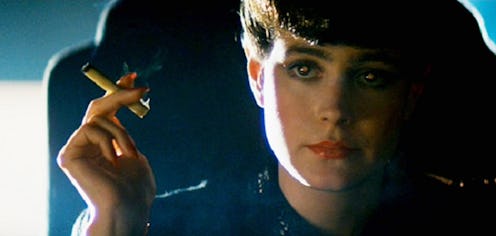
Blade Runner 2049, the long-awaited sequel to the classic 1982 sci-fi film Blade Runner, is finally here, and the film has brought back a handful of returning faces from the original film. Harrison Ford is of course back as retired blade runner Rick Deckard, Edward James Olmos appears as former LAPD officer/origami enthusiast Gaff, and even Sean Young (or rather her CGI-recreated likeness) shows up as Rachael. But just who was Rachael in Blade Runner, exactly?
In the first movie, Rachel is one of the main characters (and real life fashion icon), probably second in importance to Deckard. She is a replicant; a human-like android created by Dr. Eldon Tyrell. Replicants have a limited lifespan of four years, and are illegal to possess on planet Earth, though they can exist legally on off-world colonies. Rachael herself is an experimental replicant created by Tyrell with the goal of making her more emotionally manageable. She was implanted with memories and therefore believes herself to be a human, whereas Tyrell's previous replicants all know that they are artificially-created lifeforms. At the beginning of the film, Deckard is goaded out of his retirement as a blade runner — a bounty hunter of replicants — to track down a group of murderous androids who have illegally returned to Earth from space in an effort to extend their lifespans. This leads Deckard to Tyrell, where he meets Rachael for the first time.
After Deckard reveals to Rachael that she is a replicant, she goes on the run from Tyrell, and Deckard is ordered to find her and elmimate her along with the other replicants he's been chasing. He eventually finds her while also coming into physical conflict with one of the escaped replicants, the super strong Leon. Despite the move potentially meaning the end of her own life, Rachael saves Deckard by killing Leon, and the two of them flee to Deckard's apartment. There, the blade runner tells Rachael that he's not going to turn her in as it becomes clear that the two have developed feelings for each other. After Deckard's final confrontation with the escaped replicants, all of whom die, he returns home to find Rachael safe in his apartment. The pair of them then go on the run as the film ends, with clues hinting that Deckard is a replicant, too. So, where does that leave Rachael in Blade Runner 2049? Spoilers to follow.
The new movie picks up 30 years after the original film, and features a new blade runner, Ryan Gosling's Officer K, tracking down Deckard, who has been missing since disappearing with Rachael at the end of the first film. Once K finds Deckard, the two become embroiled in a new scandal involving Jared Leto's Niander Wallace, the creator of a new generation of advanced replicants. Toward the end of the film, Wallace creates a hologram of Rachael — long since passed away and looking exactly as she did in the original film — in an attempt to manipulate Deckard emotionally. This hologram was likely created using CGI, and it's not clear whether or not Young participated in the film's production.
Blade Runner 2049, perhaps to even a greater extent than the original Blade Runner, explores the theme of what it means to be human. This theme was greatly explored via Rachael in the first movie, as the most human-like replicant in the film (with the possible exception of Deckard), and her presence in the sequel highlights her importance in this debate. What makes a person human? Is it that we have empathy? That we can fall in love? That we can feel emotional pain? Rachael showcases all of these qualities, and the nature of her being continues to be a subject of debate among Blade Runner fans even in Blade Runner 2049.